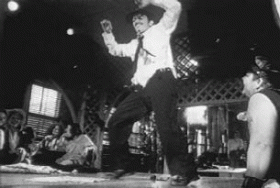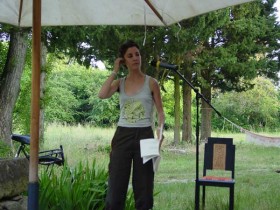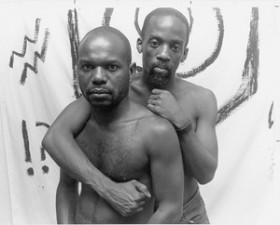A video essay uses primary footage to document the stories, challenges and acheivements of the women who, in the 1970s, attempted to transform the underlying tenets of fine art of fine art beyond terms dictated by a sexist ideology. Includes over 100 visual artists.
On the making of Not For Sale by Laura Cottingham
It was a desire for history–to know, to acknowledge, and to actively produce history–that motivated me to begin the work that has become, six years later, a 90-minute video tape called Not For Sale: Feminism and Art in the USA during the 1970s. Prior to this project, contemporary art had been my primary focus. Although the basis of my work had been established according to feminist concerns from the moment I began writing art criticism while still in college during the early eighties, it wasn’t until 1992 that it first made sense to me to go back to “the feminist decade.” As I witnessed an echo of the ’70s reverberating in contemporary works by Janine Antoni, Cheryl Dunye, Ava Gerber, Sue Williams, Lynne Yamamoto and other artists, I became aware of how little I knew about the Feminist Art Movement. Given that the late sixties and early seventies marked the moment in American history when women first identified themselves consciously as a political group and organized for the right to participate in cultural production as visual artists, it seemed imperative to me to attempt to locate this radical departure, situate the terms of its emergence, and preserve its outward appearance in art production–before it was too late to do so.
In addition to its relation to my professional practice as an art critic, returning to the 1970s allowed me access to my own historical-autobiography. As a teenager during the 1970s, this decade shaped my earliest self-adopted beliefs. Although too young to have actively participated, I have vivid childhood memories of the events circa ’68 as witnessed on television and magazine covers. Of course to consider the impact of the Women’s Liberation Movement and the mobilizations for civil rights and Black Power, anti-militarism and student rights, Gay Rights and the general challenge to traditional and governmental authority that erupted in the United States during the sixties and seventies, one is left to address the work left undone, the changes still unmade, the political tensions as yet unresolved. Obviously, change cannot happen without our assistance, just as the status quo cannot perpetrate itself without us. Where and how do we locate ourselves, individually and collectively, in this process called history?
Politics and art both share the foundational premise of consisting, ultimately, of a consideration of values; and of being defined and played out according to what resources are or are not available for the production or maintenance of values. In the intersection between politics and art that ocassioned the emergence of the Feminist Art Movement, the multiple and often contradictory artstic positions adopted by its participants were quite diverse. In the context of the ruling New York gallery art of the period–which was Minimalism–the works associated with the Feminist Art Movement are more united by their obvious departure from and against Greenbergian formalism than they are by any other organizing nomenclature.
Not For Sale introduces and reintroduces some of the art, artists, and activities of the Feminist Art Movement. Many contemporary artistic strategies and modes of production that are taken for granted in the 1990s–including video and performance work, activist-based practices, collective art efforts, sculpture and painting that incorporate materials and processes previously dismissed as craft, autobiography as subject, archival-based installations and explorations in identity politics–were first introduced and championed within the broad based aesthetics and practices that constituted the Feminist Art Movement. Although the most significant legacy of the Feminist Art Movement—its construction of a deliberately female subjectivity and its demand that women be allowed to participate in cultural production in the role of the artist–was often naive, unstable, contradictory, and partial, it nonetheless irrevocably transformed the terms for understanding the meaning of images of women, the role of women in cultural production, and the aesthetics of American Modernism.
Much of the research base for Not For Sale was drawn from the personal archives feminist artists of the 1970s had assembled of themselves and their peers. Sharing slide reproductions was one of the dominant organizational and distribution features of the Feminist Art Movement. Although 35mm slides were the standard format for most reproductive preservation of art made in the United States during the 1970s, this format is not well-suited to the video medium; and Not For Sale would be a very different product if it were, for instance, a literal rather than a virtual exhibition. As with any historical project, documentation–the literal materiality of the documents, including their accessibility, readability, and reproduction quality–greatly influenced not only the parameters of my own knowledge as a researcher, but also the possibilities available for transferring this information into the specific terms accepted by, in this case, video.
Because so few women had commercial support for their art during the 1970s, a sizable amount of the artworks I located had been reproduced and preserved according to substandard technical conditions. Even the works produced in the then-new media of video and performance were often resistant to being historicized in video in the 1990s, as many performances had purposively not been documented (out of deference to an aesthetics based in exclusively real-time experience) while other time-based works that were documented or produced in half-inch reel-to-reel had not been transferred to subsequent video formats and were therefore literally lost (first generation video tape is fugitive, much like Polaroid photography) or only partially retrievable.
Working on Not For Sale has brought me closer to the reality behind the myth of the possibilities available for revisionist history, especially when undertaken to uncover politically marginalized cultural products and events. Although a revisionist reading of dominant cultural artifacts is likely or at least possible; revisionist reclamations of marginalized cultural properties remain unlikely and difficult. Despite different obstacles to historicization, the art and artists featured in Not For Sale nonetheless account for less than 5% of the archival imagery I have assembled– itself only a small fraction of the social activities, paintings, political organizing, sculptures, panel discussions, performances, videos, consciousness raising sessions, postal mailings, activist efforts, installations and other art activities that occurred in response to and coterminous with the Feminist Art Movement that emerged throughout the United States during the 1970s. While researching, I was conscious of not wanting to repeat the terms of exclusion dictated according to ‘majority politics.’ Although the majority of women active in the feminist activist and art movements were white and heterosexual, non-white women and lesbians actively participated from the beginning of the Second Wave and I wanted Not For Sale to reflect this.
Although the movement was national, Not For Sale is biased toward activities that occurred in and around New York and Los Angeles. Even so, some events of obvious historical relevance to the concerns of Not For Sale are notably lacking due to my inability to locate either existing or functional visual documentation. These absences include art works as well as pivitol public events, such as the first feminist protests against the discrimination of women from major museums. For instance, in 1970 members of the Ad Hoc Women Artists Committee waged a spirited, sustained and successful action against the exclusion of women from the Whitney Museum of American Art’s collection and Annual. In Los Angeles the same year women protested the all-male survey exhibition “Art & Technology” at the Los Angeles County Museum of Art. The extensive textual and limited photographic documentation of these events were not easily or productively rendered into the terms of video, but will be presented in the Not For Sale companion book (forthcoming from êditions Blocnotes, Paris), which will feature additional textual description and documentation and reproductions of art that are not featured or only presented in brief or in part in the video tape.
My own aesthetic and political interests also guided the selection process. I chose works that compelled me as well as those that seem to best represent some of the movement’s dominant aesthetics tendancies and artistic investigations. The participants in the Feminist Art Movement arrived from different artistic and educational backgrounds. Some wanted to transform traditional European-derivative media, such as painting and sculpture, with feminist awareness; others, most notably the African American artists, sought to introduce non-European aesthetics and values into the American visual vocabulary. Still others eschewed object-making altogether in favor of performative strategies, championed video as the new frontier of artistic democracy, called for an elmination of the division between craft and fine art, united the aims of artistic freedom with those of political activism, or set forth an aesthetics based in an understanding of introducing female experience and female-coded labor, the female body, women’s history, and individual autobiography as the foundations for a feminist art. Although the parameters of the Feminist Art Movement can be charted according to specific historical determinants such as exhibitions, meetings, individual productions, letters, publications and other documents, the Movement was first and foremost far from a unified front. The disagreements between its participants–some of which are overtly presented in Not For Sale, while others must be inferred by the viewer–are as crucial to its definition as the consensus that inspired and sustained it across ideological ruptures, personal frustrations, and a general lack of access to significant economic or institutional resources. Participants in the Feminist Art Movement of the 1970s were motivated to transform the underlying tenants of fine art–including the production, critical evaluation, exhibition, distribution, and historical maintenance of art–beyond terms dictated by sexism. The challenge they offered has yet to be met.




